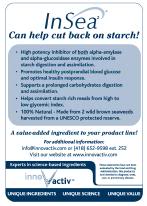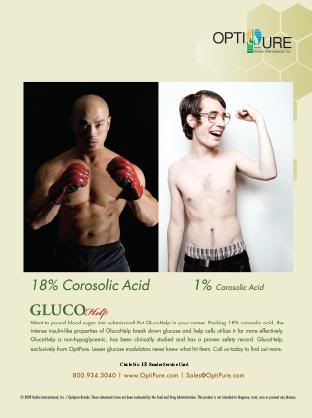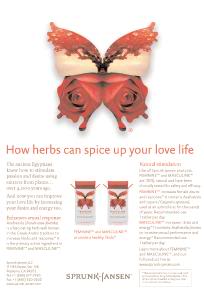If you feel like challenging the adage, "You can never have too much of a good thing," make the case with carbs. Eating too many refined carbs and sugar (combined with not enough exercise and some genetic factors thrown in) may put one at risk for diabetes.
In a healthy person, sugars and starches are broken down into glucose, which then is used to fuel the body. The pancreas produces just the right amount of insulin to help glucose enter the cells, which they need for energy and to grow. On the other hand, diabetics cannot produce enough insulin or—as is often the case with type-2 diabetics—don't use the insulin appropriately. As a result, the glucose overload in the blood damages tissue and the body doesn't have enough fuel to keep it running properly. Over time, the eyes, heart and kidney pay a steep toll for high glucose levels.
|
Understanding Type-1 and Type-2 Diabetes |
It's not all gloom and doom, though. Nearly every diabetic will feel better when they eat a healthy diet, and supplements can make a difference, too, depending on the individual.
Doing a 180
When dealing with shoppers who have been told they are at risk of developing type-2 diabetes, retailers must convey some practical optimism. Getting out of the warning zone may not be a piece of cake (pun intended), but lifestyle and nutritional changes can help. Says Grace Ormstein of Himalaya Herbal Healthcare USA, Houston, TX, "The same lifestyle changes that can treat or even reverse pre-diabetes, can prevent the condition from occurring. Mainly, pre-diabetics must focus on eating healthy foods, getting more physical activity and losing excess weight. Making [this commitment as] part of the daily routine is very important."
Before diving into specifics, it's important to understand pre-diabetes. This condition implies that blood glucose levels are higher than normal, but not high enough to be at diabetic levels. Some evidence suggests that these higher glucose levels may be enough to cause long-term damage to the heart, nerves and circulatory system and if not addressed, many pre-diabetics eventually become diabetic (1). It's important to note that pre-diabetes may lead to type-2 diabetes, which is generally considered a nutritional disorder that develops over time; type-1, on the other hand, is an autoimmune disease that often appears early in life.
A first step toward addressing pre-diabetes is "to get the body moving," says Chris D. Meletis, N.D., director of science and research for Trace Minerals Research of Ogden, UT, and a member of the firm's research advisory board. "A body in motion stays in motion; a body at rest stays at rest…there is no better time than now to get some healthy momentum and break inertia." In fact, the Diabetes Prevention Program Study indicated that those who exercised 30 minutes five times per week lost weight (6–7% of total weight) and slashed their risk of developing diabetes by 60% (2).
Lucien Hernandez, president and CEO of Natreon, Inc., New Brunswick, NJ, adds, "Obesity is the single most controllable risk factor and the single most important because it potentiates other risk factors. [It] has cascading negative effects on metabolic wellness."
In addition to weight loss, exercise causes some important biological changes for pre-diabetics. Deanne Dolnick, director of sales for Next Pharmaceuticals, Salinas, CA, explains that exercise, especially cardiovascular, increases the cells' ability to absorb glucose.
Dietary habits, too, can make a positive impact on blood glucose levels. Says Frank Assumma, director of marketing for Natural Health Science, Hoboken, NJ, "The most important lifestyle changes are to eat smaller meals and not to overeat. Eat well-balanced meals where you sit down and don't eat on the go." Moving from three large meals to several small ones helps prevent fluctuations in blood glucose levels, which can lead to hypoglycemia and fat storage.
As for what to eat, many consumers know to stay clear of sugar, which can cause glucose levels to spike dangerously high. But, there's more to the story. Says Bradley R. West, N.D., research advisor for Nordic Naturals, Watsonville, CA, "Type-2 diabetes is your body telling you that it cannot handle carbohydrates efficiently…This means eliminating not only sugary snacks, but also carbohydrates that contain no fiber, otherwise known as the white foods."
He explains that these blood sugar-raising foods (e.g., white bread, white pasta, white rice and junk food snacks) have no fiber to slow down their effect on blood sugar. "They, in essence, have the same effect on blood sugar as sugary foods and should be minimized considerably and/or replaced with the higher fiber or the brown versions," West explains. Studies show that eating a high-fiber diet is associated with reduced risk of type-2 diabetes and lower presence of metabolic syndrome (3).
Richard Passwater, Ph.D., vice president of research and development at Solgar, Inc., Leonia, NJ, gives us some other key components of a diet for pre-diabetics: "A healthy diet for those with diabetes should include moderately high protein such as fish and chicken, and a lot of vegetables."
Retailers can also help shoppers manage food cravings. Meletis notes, "Clinically, I find that chromium acts as will power in the bottle. In short, the lower the chromium, the higher the cravings; the more carbs, the lower the chromium levels. This becomes a catch-22."
Also, choosing low-glycemic index (GI) foods such as whole grains help promote satiety. New research indicates that eating low-GI meals may increase the serum levels of GLP-1, a hormone made in the gut that causes a feeling of fullness (see "Link Between Low-GI Meals and Satiety Found" on page 10). Retailers can help with consumer education about the GI index, which can help diabetics manage their sugar levels "by serving as a good guide for meal planning," says Passwater.
Steve Holtby, president and CEO of Soft Gel Technologies, Inc., Los Angeles, CA, briefly explains how the system works: "The glycemic index refers to carbohydrates contained in different foods and ranks them on how they affect blood glucose levels, compared to a reference carbohydrate. Usually glucose is the benchmark, having a glycemic index value of 100. This allows for values to be interpreted as percentages on an absolute scale. Since not all carbohydrates are digested the same way, this index measures the increase in blood sugar a couple hours after eating."
The index assigns a high number to foods that are broken down quickly and cause blood glucose levels to rapidly rise. Lower numbers mean energy is released slowly and steadily, so blood sugar doesn't spike. According to Passwater, the GI isn't just for diabetics: "Foods with low GIs are better for everyone…Everyone, especially diabetics, should eat foods made up of complex carbohydrates (low and moderate GI foods) in order to normalize blood sugar levels."
 Remember, too, that improving a pre-diabetic's diet isn't just about refined carbs; you've got to watch the fat, too. Says Tim Romero, president of Integrity Nutraceuticals International, Spring Hill, TN, "A big misconception is that all you need to watch is your sugar intake. It is equally as important to watch fat intake. Reducing carbohydrate intake and watching the fat is crucial to maintaining glucose levels within normal ranges."
Remember, too, that improving a pre-diabetic's diet isn't just about refined carbs; you've got to watch the fat, too. Says Tim Romero, president of Integrity Nutraceuticals International, Spring Hill, TN, "A big misconception is that all you need to watch is your sugar intake. It is equally as important to watch fat intake. Reducing carbohydrate intake and watching the fat is crucial to maintaining glucose levels within normal ranges."
For example, eating too much saturated fat, trans-fatty acids and omega-6 fatty acids (found in vegetable oils) "all seem to increase the risk of insulin resistance," says Holtby.
Supplements for Diabetics
When combined with proper diet and sufficient exercise, dietary supplements can play an important part in healthy living for those diagnosed with type-1 and type-2 diabetes. Says Michael T. Murray, N.D., director of product development and education at Natural Factors, Everett, WA, "A person with diabetes has higher requirements for many nutrients. Clinical studies have shown that supplementation with key nutrients can improve blood sugar control, as well as help prevent or reduce the development of major diabetes complications. Furthermore, taking a multiple vitamin and mineral supplement has also been shown to boost immune function and reduce infections in diabetics."
Retailers should always take extra care to explain that supplements aren't a substitute for diet and exercise (nor prescribed medication like insulin), and one should always seek the permission of a healthcare provider before adding a supplement to one's daily regimen. This is especially important for insulin-dependent clients.
Here is a brief primer on some of the many offerings in the diabetes support category.
Chromium. Chromium is part of the glucose tolerance factor, which helps insulin shuttle glucose into cells. Chromium's role may in fact be to help insulin bind to the cell membrane. Without enough chromium, blood sugar levels tend to stay high because glucose isn't transported into the cell. Holtby adds other ways in which chromium picolinate helps by "increasing the number of insulin receptors…; increasing insulin receptor phosphorylation; and by increasing GLUT4 translocation (a specific facilitative glucose transporter that helps shuttle glucose into the cell)."
Whether it's a cause or an effect of the condition, Dolnick notes that many diabetics are "deficient in this essential mineral and when given chromium, their blood glucose levels improve as well as many of the complications that accompany diabetes."
Though more research is needed, the Office of Dietary Supplements says, "chromium supplements might help to control type-2 diabetes or the glucose and insulin responses in persons at high risk of developing the disease" (4).
One raw materials company pairs a novel complex of trivalent chromium with Indian gooseberry and Shilajit. "In clinical trials, the complex has demonstrated adaptogenic and antioxidant properties for treating, preventing or managing dysfunctions related to glucose metabolism," says Hernandez of Natreon, who explains that the herbal components protect the chromium from oxidation to toxic Cr6+. He notes that the complex lowers fasting and post-prandial blood glucose, glycosylated hemoglobin, C-reactive protein and LDL cholesterol.
Magnesium. About 75% of all Americans don't get enough magnesium, with deficiency ranges for diabetics varying from 25 to 39% (3). Lack of magnesium in this group is important to note because it causes elevated glucose and insulin levels. Proper amounts of this mineral are essential for proper glucose balance and transport, as well as regulating energy production and releasing insulin—all necessary elements of carbohydrate metabolism. "When insulin is released from the pancreas, magnesium in the cell normally responds and opens the cell to allow entry of glucose, but in the case of magnesium deficiency combined with insulin resistance, the normal mechanisms just don't work. However, the higher the levels of magnesium in the body, the greater the sensitivity of the cells to insulin and the possibility of reversing the problem," says medical and naturopathic doctor Carolyn Dean, M.D., N.D. (5).
According to Dean, low magnesium levels may even be a marker for diabetes, as it affects as many as 40% of diabetic patients. She cites three large studies (totaling 168,000 subjects) in which "people with the highest levels of the mineral magnesium in their diets have the lowest risk for developing diabetes," and adds, "It's important that this information be promoted more widely" (5).
Other vitamins and minerals such as vanadium, biotin and vitamin D help maintain normal blood sugar levels, too.
 Essential Fatty Acids. Some evidence indicates that diabetes is linked to inflammation; specifically, many diabetics have high C-reactive protein, a marker of inflammation. And, many conditions associated with diabetes such as artery disease and atherosclerosis also may be linked to inflammation (6). Some research indicates that diabetics who take fish oil supplements or eat fish have a lower chance of developing coronary heart disease. According to West, fish oil also helps increase insulin sensitivity. A high-potency blend of EPA and DHA (found in fish oil), he explains, "increases cell membrane fluidity and increases insulin receptor sensitivity."
Essential Fatty Acids. Some evidence indicates that diabetes is linked to inflammation; specifically, many diabetics have high C-reactive protein, a marker of inflammation. And, many conditions associated with diabetes such as artery disease and atherosclerosis also may be linked to inflammation (6). Some research indicates that diabetics who take fish oil supplements or eat fish have a lower chance of developing coronary heart disease. According to West, fish oil also helps increase insulin sensitivity. A high-potency blend of EPA and DHA (found in fish oil), he explains, "increases cell membrane fluidity and increases insulin receptor sensitivity."
West adds that alpha lipoic acid (ALA), "enhances glucose uptake and promotes insulin sensitivity, with the added bonus of preventing Advanced Glycation Endproducts (AGEs)." People with hyperglycemia or poorly managed blood sugars, West says, "have more AGEs and thus more health problems." Antioxidants that reduce AGEs include resveratrol and green tea extract.
Omega-3s are also known to help maintain healthy cholesterol levels. Diabetics often have high triglyceride and low HDL levels, and fish oil may "help lower triglycerides and apoproteins (markers of diabetes), and raise HDL, so people with diabetes may benefit from eating foods or taking supplements that contain DHA and EPA," according to the University of Maryland Medical Center (7).
 French maritime pine bark extract. In the diabetes category, much current research focuses on botanical extracts and their ability to inhibit alpha-glucosidase, says Frank Schönlau, director of scientific communications for Horphag Research of Geneva, Switzerland. Intestinal enzymes take apart complex carbohydrates (like starch) and turn them into single glucose molecules. "Alpha-glucosidase rapidly liberates the glucose from starch for subsequent absorption into the blood stream," says Schönlau, so inhibiting this action may benefit diabetics.
French maritime pine bark extract. In the diabetes category, much current research focuses on botanical extracts and their ability to inhibit alpha-glucosidase, says Frank Schönlau, director of scientific communications for Horphag Research of Geneva, Switzerland. Intestinal enzymes take apart complex carbohydrates (like starch) and turn them into single glucose molecules. "Alpha-glucosidase rapidly liberates the glucose from starch for subsequent absorption into the blood stream," says Schönlau, so inhibiting this action may benefit diabetics.
One well-researched botanical that may help on this front is French maritime pine bark extract (Pycnogenol). Says Schönlau, "Pycnogenol is so effective because it is especially rich in long-chained procyanidins and these molecules are the most potent inhibitors of alpha-glucosidase."
Passwater notes that this attribute may help delay sugar absorption and inhibit alpha-glucosidase better than certain medications. He cites a recent study in which "Pycnogenol delayed the uptake of glucose from a meal more than prescription medications, preventing the typical high-glucose peak in the bloodstream after a meal (8). The study revealed that pine bark is more potent for suppressing carbohydrate absorption in diabetes than synthetic prescription alpha-glucosidase inhibitors." He adds the study indicated Pycnogenol was 190 times more potent than the drug (Acarbose) for this application.
Schönlau notes an added bonus for diabetics: the extract may help improve endothelial function. "The endothelium, cells lining the wall of blood vessels, plays a key role for controlling vascular function such as artery relaxation and blood platelet ‘stickiness.' In diabetes, the high blood sugar level disturbs the ability of the endothelium to generate the nitric oxide required to release artery constriction. This is the major reason why every second type-II diabetic has hypertension," he says. Studies indicate that Pycnogenol helps lower high blood sugar levels in type-II diabetics and also maintains healthy blood pressure.
Cinnamon. Another important diabetes-support ingredient is cinnamon, which may help increase insulin sensitivity. Romero offers some information about cinnamon research: "Bolin Qin, M.D., Ph.D., has been instrumental in building the research portfolio of this product. Dr. Qin's research demonstrated the link of poor glucose regulation and its effects on apolipoproteins. The insulin cascade is far more than simply supporting healthy glucose. When your insulin isn't working properly it can lead to a plethora of other negative effects in the body."
 Some research indicates that consuming one to six grams of cinnamon may be enough to reduce serum glucose, triglycerides, LDL cholesterol and total cholesterol in type II diabetics.
Some research indicates that consuming one to six grams of cinnamon may be enough to reduce serum glucose, triglycerides, LDL cholesterol and total cholesterol in type II diabetics.
Holtby explains why this ingredient may help: "Recently, researchers at the Human Nutrition Research Center of the U.S. Department of Agriculture have isolated and characterized insulin-enhancing complexes, water-soluble polyphenolic polymers, from cinnamon that may function as antioxidants, and may alleviate or control glucose intolerance and diabetes."
Saltbush. Retailers should note an interesting trend in the supplements market: "The biggest change in the field is the use of synergistic blends of traditional nutrients and botanicals, combined with popular new international herbs," observes Meletis. "The most progressive trend in the field is the incorporation of international herbs and non-western botanicals."
Sprunk-Jansen is one company using such international herbs, specifically those used in traditional Greek-Arabic medicine. For the diabetes market, Stephen Fulder, Ph.D., a science advisor to Sprunk-Jansen, Santa Rosa, CA, explains one particular herb of interest: saltbush (Atriplex halimus, Chenopodiaceae). "Work with the Bedouin of the Middle East revealed that this was their primary anti-diabetic plant," says Fulder, who notes, "The anti-diabetic effects of this plant has been confirmed in some remarkable research."
Fulder says that in small-animal studies, saltbush helped restore insulin sensitivity and reduce insulin resistance. "Its active ingredient may be a form of organic chromium," he explains, noting that Sprunk-Jansens's diabetes support supplement combines saltbush with other herbs including olive leaf to help reduce sugar absorption and blood fats (9). Fulder states, "The combination of herbs rather than any single one will help to reduce diabetes related complications, since they not only reduce blood sugar, but also remove toxic waste products from the body and stabilize the metabolism."
Other herbs. Herbal supplements have a large contingency in the diabetes support category. In addition to the aforementioned ingredients, plant-based agents that may benefit diabetics include the following:
- The corosolic acid present in loquat leaves is known to "activate facilitative blood glucose transporters. These carrier proteins help utilize glucose more efficiently without causing hypoglycemia," says Holtby. He also notes that banaba leaves contain this acid, so the herb may also help control blood sugar levels while preventing kidney and vascular damage.
- A proprietary blend of cork tree and polymethoxylated flavones (Flavoxine from Next Pharmaceuticals) was shown in a clinical trial to drop the blood sugar of overweight subjects by 9.5% after a month and by 19.6% after two months, according to Dolnick.
- Gymnema sylvestre is widely used in Ayurvedic medicine to help control glucose levels, according to Lakshmi Prakash, Ph.D., vice president of innovation and business development at Sabinsa Corp., Piscataway, NJ. Studies say that water extracts from the leaves may improve sugar assimilation in animal models. "The active principles include a glycoside mixture, the gymnemic acids and a peptide, gurmarin, both of which inhibit the sweet taste response in mammals," she explains, noting that studies on types-1 and –2 diabetics found the herb can "induce the pancreas to secrete insulin."
- Prakash also explains that bitter melon may reduce blood glucose levels. "Although the precise mechanism of action remains to be fully determined, Momordica charantia is a proven hypoglycemic agent," she says. Experiments show this herb is particularly helpful in lowering blood sugar levels in type-2 diabetics. Ormstein adds a note on bitter melon, which "helps support normal blood sugar levels with compounds called charantin and momordicin. Additional key compounds such as vicine, peptides and polypeptide-p (plant insulin) also work together to give bitter melon its potency."
- American ginseng may help decrease fasting blood glucose, hemoglobin Alc and postprandial blood glucose levels, according to Holtby, referencing supporting literature.
- Fenugreek may have a hypoglycemic effect, says Prakash. She explains that about half of this herb is fiber, "of which 20% is mucilaginous fiber similar to guar gum, a known hypoglycemic agent." The "protein fraction of the seeds," she adds, "contains the amino acid 4-hydroxyleucine, which has been proven to stimulate insulin production. Saponins present in fenugreek seeds have also been shown to lower cholesterol levels in human subjects."
- Vijayasar may help manage diabetes, Salacia reticulata may block alpha-glucosidase to limit starch digestion and lower blood sugar after meals, Holy basil may decrease blood glucose levels, and Guduchi may enhance insulin secretion and improve glucose metabolism, according to Prakash.
Brown seaweed. Carb blockers may be another supplement option for diabetics. According to information provided by Oceanova Biotechnologies, Rimouski, QC, Canada, a proprietary blend of purified polyphenols from brown seaweed (InSea) may help on this front. The ingredient is said to slow down the digestion of carbs by "selectively and effectively inhibiting both pancreatic alpha-amylase and intestinal alpha-glucosidase enzymes." By blocking these enzymes (whose job it is to break down long starch molecules into smaller pieces), glucose uptake and insulin levels are reduced 30 minutes after eating starchy foods. The company says this ingredient is effective on a wide variety of carb sources, including table sugar.
Other starch blockers include white kidney bean extracts and high-viscosity fibers.
Polysaccharides complex. Another branded supplement (PGX from Natural Factors) also supports healthy glucose levels by slowing digestion and carbohydrate absorption. When added to or taken with food, this proprietary polysaccarides complex, says Murray, can "reduce the glycemic index of the food by an amazing 50–70%." As a result, glucose levels after meals usually drop 35–70% and insulin secretion drops 40%.
With respect to restoring insulin sensitivity, Murray says this supplement improves the way the cells react to insulin by 60%. The supplement "increases insulin sensitivity and decreases blood insulin levels better than any drug," "improves diabetes control and dramatically reduces the need for medications or insulin in the diabetic," and "stabilizes blood sugar control in the overweight and obese," according to Murray.
He adds that the supplement addresses other health problems that many diabetics deal with, including being overweight. Murray explains that the supplement promotes satiety; clinical studies indicate that it helps "reduce appetite and promote effective weight loss, even in the morbidly obese." And, studies have found that the supplement helps lessen the quantities of compounds that stimulate overeating. It is also said to maintain healthy cholesterol levels.
Medicinal mushrooms. Mushroom supplements may help manage diabetes as well as related conditions like hypertension and obesity. Maitake mushroom fraction (SX Fraction from Maitake), Agarius blazei, reishi and cordyceps all have been studied for their positive effects on glycemic levels.
Diabetic Complications
Diabetes affects much more than just blood sugar levels and heart health. Diabetics are at risk for several complications that affect the kidneys, skin, eyes and more. When too much glucose circulates in the blood for too long, says Gene Bruno, M.S., M.H.S., consultant to Jarrow Formulas and dean of academics at Huntington College of Health Sciences, cells in the eyes and kidney become damaged. "Specific nutraceuticals can help to reduce the formation of glycosylated proteins and cellular sorbitol, which in turn may help to reduce the risk of certain complications." For example, a chromium, biotin and gymnema combination product (Jarrow's Glucose Optimizer) "can reduce glycosylated hemoglobin," he says. Kidney failure is a serious concern if glucose levels aren't addressed. If the kidneys become damaged and overworked, the organs cannot filter the blood properly and dialysis may be needed.
With respect to eye health, diabetics are at increased risk for glaucoma, cataracts and can develop diabetic retinopathy. With this condition, says Assumma, "the capillaries in the eye do not properly nourish the light sensing cones and rods of the retina. The capillaries also ‘spill' blood into the retina, which causes eye damage that is irreversible and which can gradually lead to vision loss."
Controlling blood sugar is key to addressing this condition, but some supplements may protect capillaries from oxidative damage. Billberry, astaxanthin, grapeseed extract and blackcurrant all have been studied for this application. Other research on Pycnogenol shows the supplement taken over six months "can stop the progression of retinopathy and help save the remaining eyesight," says Assumma.
Skin disorders may be caused by poor circulation to the extremities. "Lack of nourishment leads to a dry, cracking epidermis. It also puts them at a very high risk for infection because if there is poor blood flow to an open wound, scrape or other abrasion, the area takes an extremely long time to heal," says Brigitte Rau, owner, Brigit True Organics, Charlottesville, VA.
Most diabetes-related skin disorders are preventable, and many natural products can help. For example, a skincare line for diabetics from Brigit True Organics combines the "moisturizing properties of olive oil along with healing and stimulating herbal treatments to maintain healthy skin, soothe irritations and prevent skin issues," says Rau. Specific herbs in the line include organic calendula, St. John's wort and comfrey, "which have been scientifically proven to help soothe irritation, fight bacteria/fungus, and heal wounds naturally." The firm also believes certain essential oils used in its foot cream for diabetics "support increased blood flow in the capillaries and activate the lymphatic system."
Also offering skin care for diabetics is Masada Health & Beauty Corp., Chatsworth, CA, whose products are formulated with Dead Sea salt and minerals, which "are known for their therapeutic properties, urea helps keep the skin hydrated while increasing the moisture retention and vitamins A, C, E, and K nourish and encourage natural skin renewal," explains Mary Beth Bennett, national sales manager.
 Researchers are also looking for quicker ways to help heal diabetic skin ulcers. In one study on Pycnogenol, "ulcers healed faster and the researchers measured the blood flow velocity by Laser Doppler of skin capillaries. With Pycnogenol the micro-circulation was significantly enhanced. Moreover, they found a much higher tissue oxygen level around the ulcers, suggesting that Pycnogenol helps restore tissue blood perfusion, which sets the groundwork for the ulcer to heal," states Schönlau.
Researchers are also looking for quicker ways to help heal diabetic skin ulcers. In one study on Pycnogenol, "ulcers healed faster and the researchers measured the blood flow velocity by Laser Doppler of skin capillaries. With Pycnogenol the micro-circulation was significantly enhanced. Moreover, they found a much higher tissue oxygen level around the ulcers, suggesting that Pycnogenol helps restore tissue blood perfusion, which sets the groundwork for the ulcer to heal," states Schönlau.
And, interesting research is underway at the University of Montana to study the treatment of diabetic ulcers with a topical xylitol and lactoferrin solution.
Bennett raises the point that diabetics may experience nerve damage, which may be caused by free radicals. ALA, she says, may "help with the pain, burning and tingling of diabetic neuropathy."
Holtby agrees, explaining that ALA and also GLA "may improve nerve communication in damaged areas by improving blood flow to peripheral nerves and stimulating the regeneration of nerve fibers. One research review looked at the 15 clinical trials that had been performed with ALA to date. The researchers concluded that the three-week treatment using 600 mg per day of the ingredient reduced the chief symptoms of diabetic neuropathy."
It should be noted that one formulation trend in the diabetic support market is the development of supplements that not only address blood sugar, but also some of the effects mentioned in this section. Says Bruno, "One innovation is the combining of ingredients to help address the ramifications of long-term high blood glucose levels, rather than just providing ingredients to reduce glucose levels. Those ramifications include but are not limited to, suboptimal functioning of the nerves, eyes and kidneys, difficulty walking long distances, and less than optimum blood pressure, cholesterol and triglyceride levels."
 Sabinsa's Prakash agrees, and notes how herbal supplements fit in: "[Herbs offer] nutritional support in the form of phytonutrients that beneficially influence carbohydrate metabolism and offer antioxidant and anti-inflammatory support (as inflammation is now considered to be the root cause of most chronic diseases)."
Sabinsa's Prakash agrees, and notes how herbal supplements fit in: "[Herbs offer] nutritional support in the form of phytonutrients that beneficially influence carbohydrate metabolism and offer antioxidant and anti-inflammatory support (as inflammation is now considered to be the root cause of most chronic diseases)."
As an example, Bruno speaks of a supplement (Glucose Optimizer from Jarrow Formulas) that combines ingredients for healthy insulin sensitivity (ALA, chromium, biotin and Gymnema sylvestre) with others for healthy erve function (vitamin B12 as Methylcobalamin), cholesterol levels/blood pressure (green tea extract) and eye function (bilberry extract).
Himalaya Herbal Healthcare USA is also working in this area. According to Ormstein, "We have discovered herbs that address these conditions and the products are under development as potential herbal therapies for anti-diabetic and diabetic secondary complications. We have filed a U.S. patent for the same." WF
References
1. American Diabetes Association, www.diabetes.org, accessed May 26, 2009.
2. NIH, "Diet and Exercise Delay Diabetes and Normalize Blood Glucose," www.nih.gov/news/pr/feb2002/hhs-06.htm, accessed May 26, 2009.
3. F. Murray, Natural Supplements for Diabetes (Basic Health Publications, Laguna Beach, CA, 2007).
4. Office of Dietary Supplements, "Dietary Supplements Fact Sheet: Chromium," http://ods.od.nih.gov/
factsheets/chromium.asp, accessed May 27, 2009.
5. C. Dean, The Magnesium Miracle (Ballantine Books, New York, NY, 2007).
6. J.C. Maroon and J. Bost, Fish Oil: The Natural Anti-Inflammatory (Basic Health, Laguna Beach, CA, 2006).
7. U. of Maryland Medical Center, "Omega-3 Fatty Acids," www.umm.edu/altmed/articles/omega-3-000316.htm, accessed May 27, 2009.
8. A. Schaffer and P. Hogger, "Oligomeric Procyanidins of French Maritime Pine Bark Extract (Pycnogenol) Effectively Inhibit Alpha-Glucosidase," Diabetes Res. Clin. Pract. 77 (1), 41–46 (2007).
9. O. Said, et al., "Maintaining A Physiological Blood Glucose Level with ‘Glucolevel', A Combination of Four Anti-Diabetes Plants Used in the Traditional Arab Herbal Medicine," eCAM 2007; doi:10.1093/ecam/nem047.
Published in WholeFoods Magazine, July 2009










